
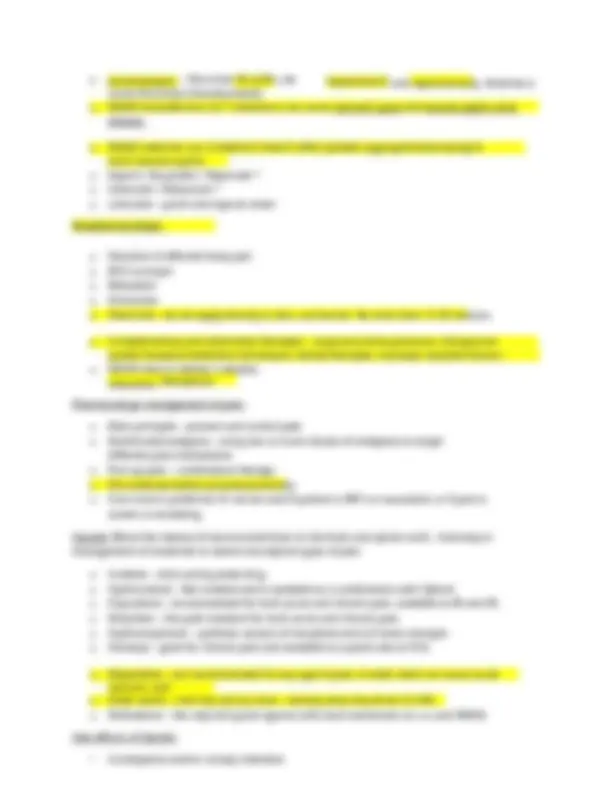

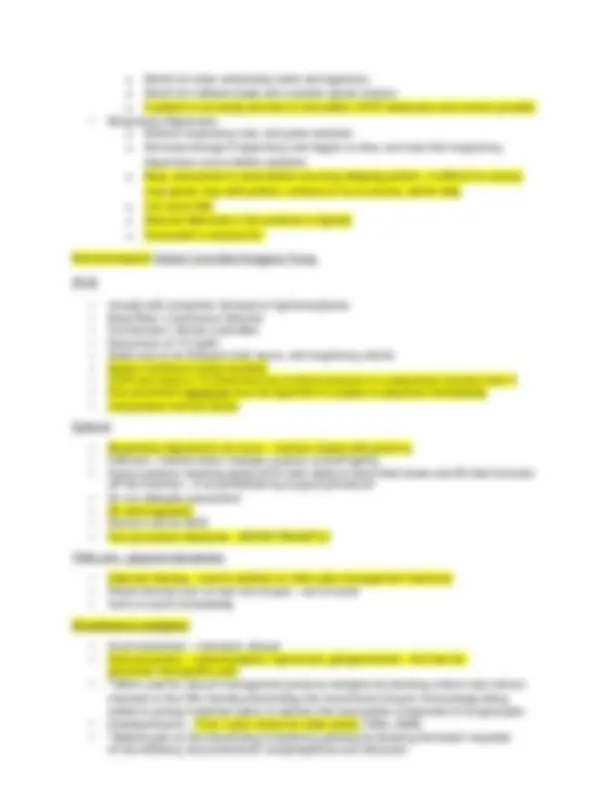
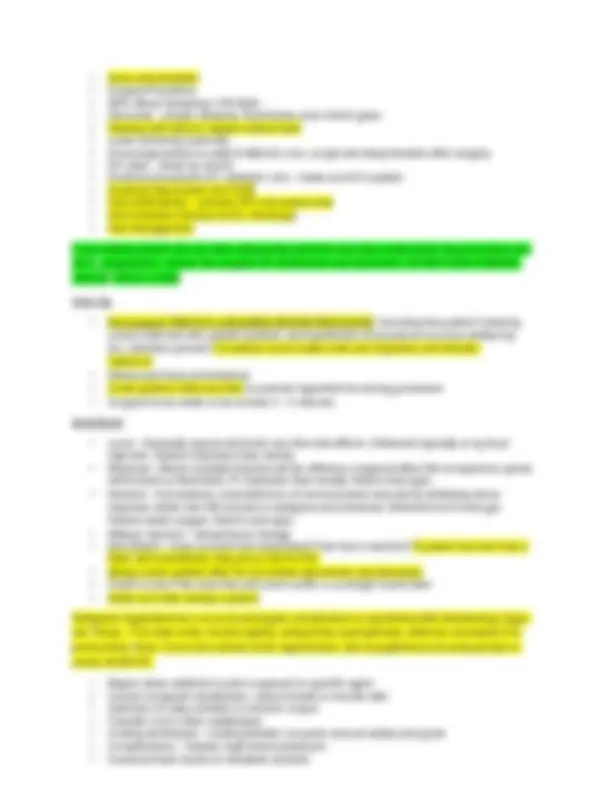
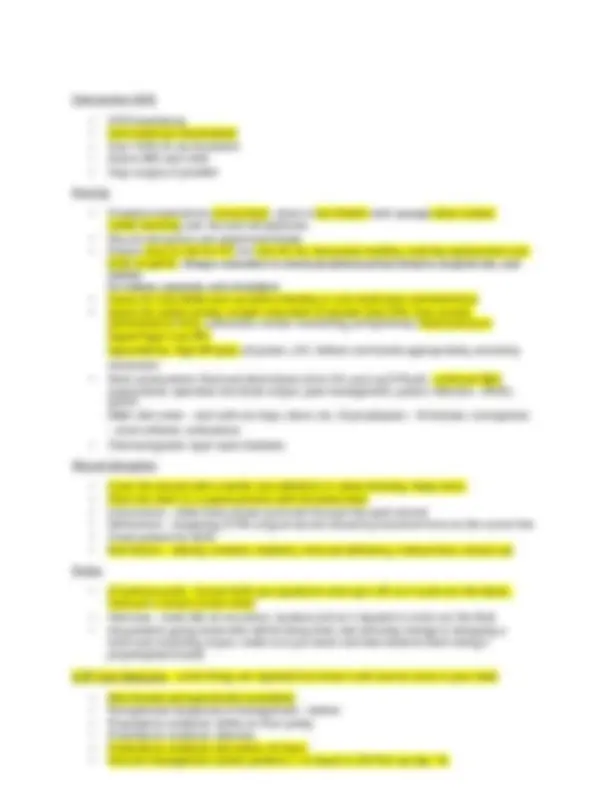

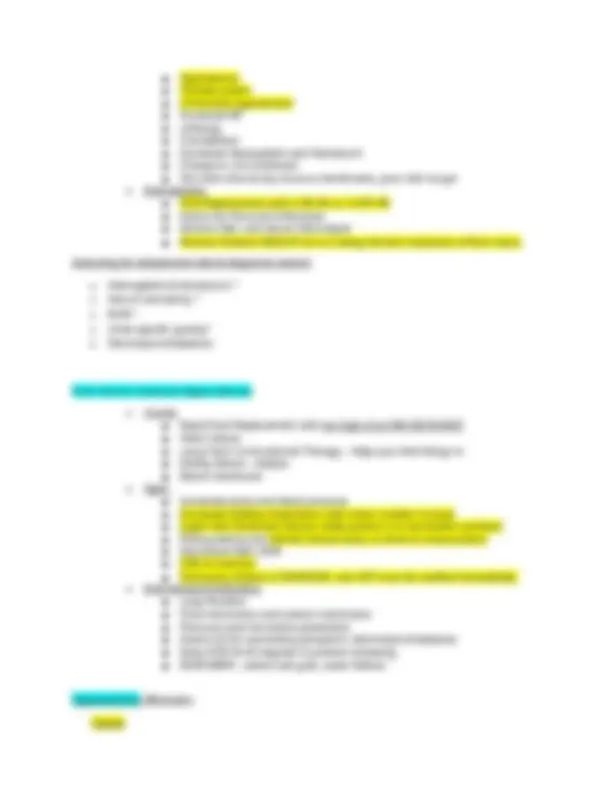
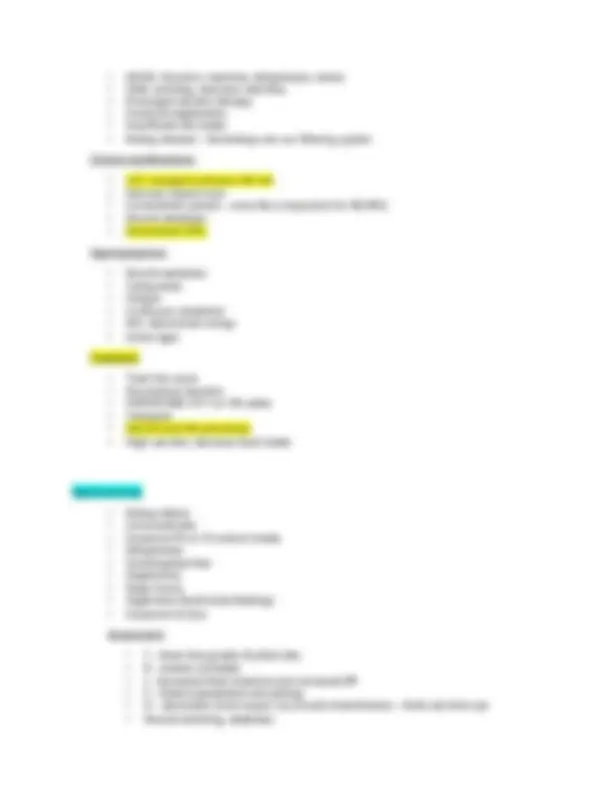
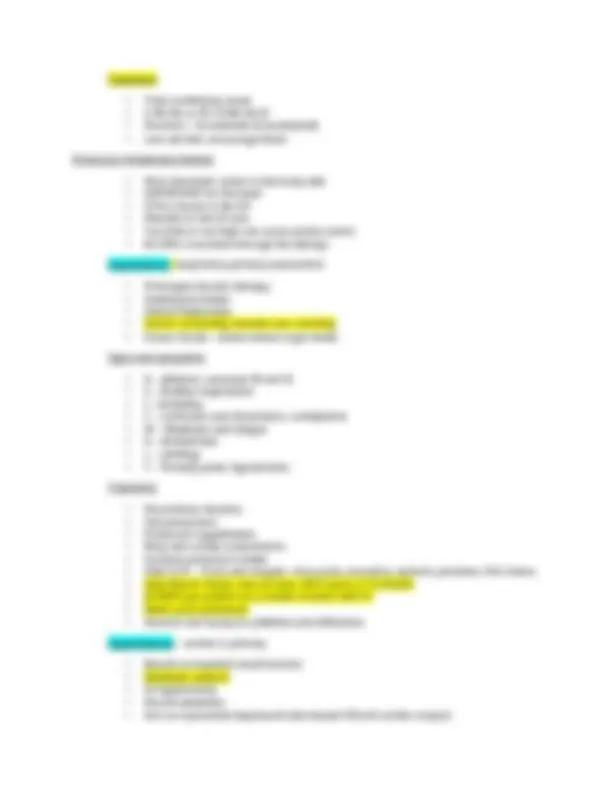
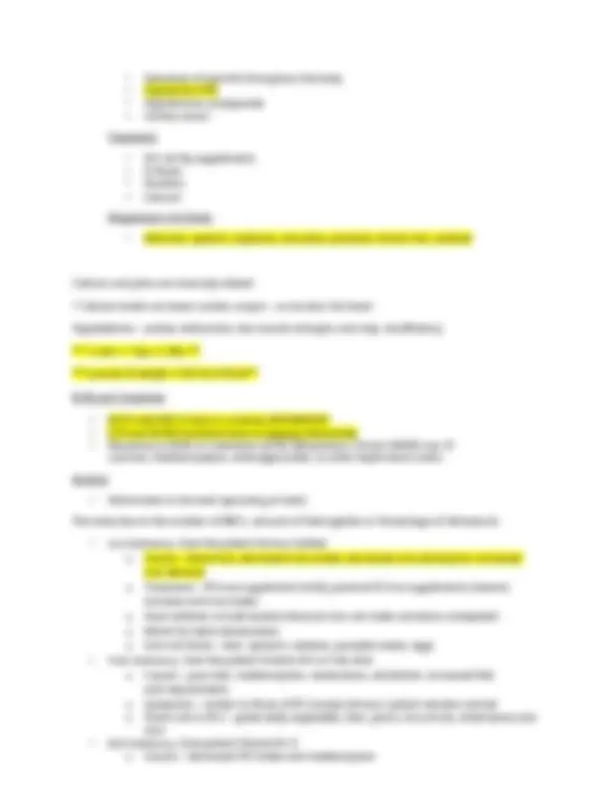

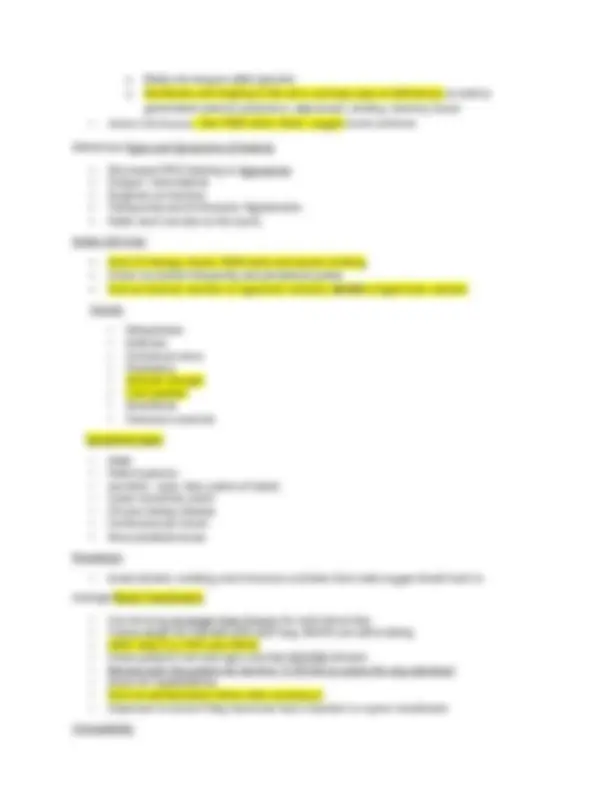
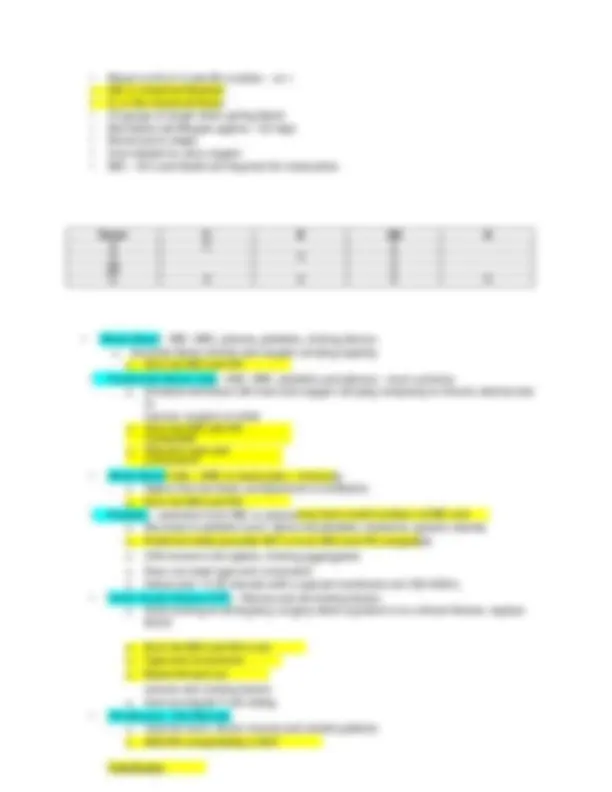
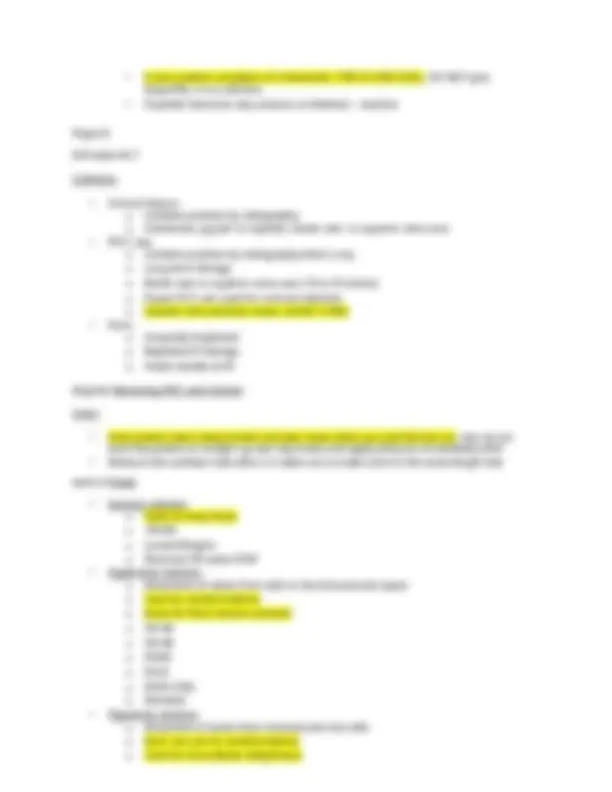

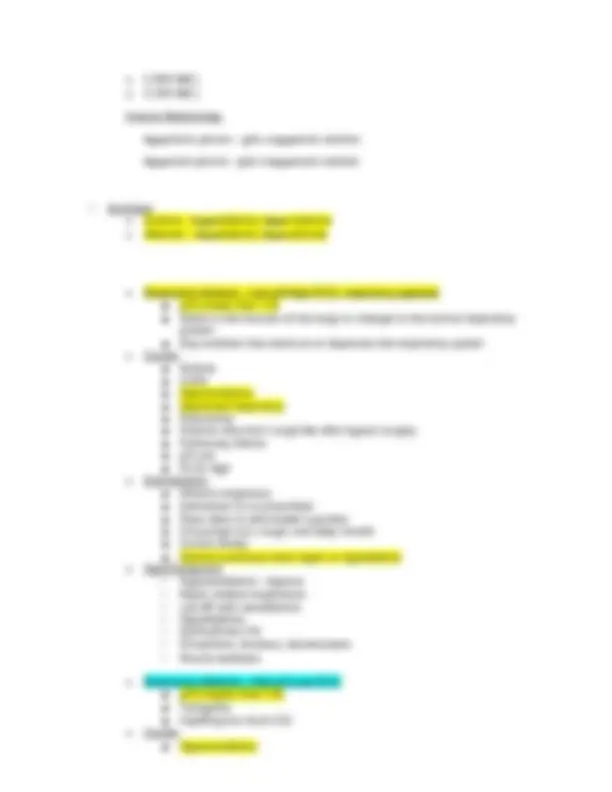
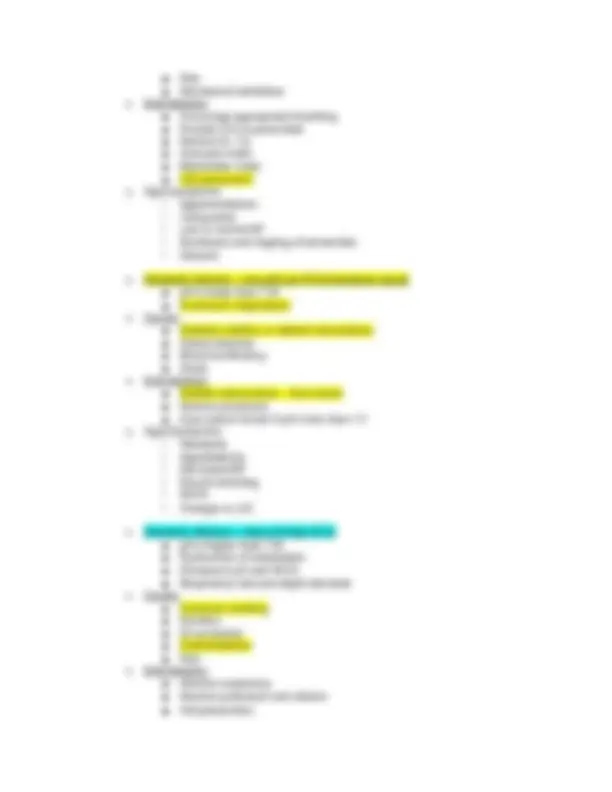



Study with the several resources on Docsity

Earn points by helping other students or get them with a premium plan


Prepare for your exams
Study with the several resources on Docsity

Earn points to download
Earn points by helping other students or get them with a premium plan
Community
Ask the community for help and clear up your study doubts
Discover the best universities in your country according to Docsity users
Free resources
Download our free guides on studying techniques, anxiety management strategies, and thesis advice from Docsity tutors
Pain The 5th Vital Sign Characteristics of Acute and Chronic Pain ▪ Acute Pain (sudden onset, trauma, accident) – usually hours to days o Increased Heart Rate Blood Pressure and Respiratory Rate o Dilated Pupils and Sweating o Results from sudden, accidental trauma, surgery; ischemia, inflammation ▪ Chronic Pain (persistent long term) – usually longer than 3 months o Dull, Burning Sensation Types of Pain ▪ Nociceptive Pain (normal pain) o Somatic Pain – Superficial or Subcutaneous Tissue felt by sharp, burning. o Deep Somatic – Bone, Muscle, Blood Vessel, Connective Tissues. o Visceral Pain – Organs and Linings of Body Cavities felt by deep cramping, splitting, sharp. ▪ Neuropathic Pain (abnormal pain) Give Gabapentin o Nerve Fibers, Spinal Cord, Central Nervous system felt by shooting, fiery, burning, sharp, numbness. o DM, phantom limb pain, HIV neuropathies How to assess pain
Typology: Exams
1 / 26

This page cannot be seen from the preview
Don't miss anything!



















Pain The 5
th
Vital Sign
Characteristics of Acute and Chronic Pain
▪ Acute Pain (sudden onset, trauma, accident) – usually hours to days
o Increased Heart Rate Blood Pressure and Respiratory Rate
o Dilated Pupils and Sweating
o Results from sudden, accidental trauma, surgery; ischemia, inflammation
▪ Chronic Pain (persistent long term) – usually longer than 3 months
o Dull, Burning Sensation
Types of Pain
▪ Nociceptive Pain (normal pain)
o Somatic Pain – Superficial or Subcutaneous Tissue felt by sharp, burning.
o Deep Somatic – Bone, Muscle, Blood Vessel, Connective Tissues.
o Visceral Pain – Organs and Linings of Body Cavities felt by deep cramping,
splitting, sharp.
▪ Neuropathic Pain (abnormal pain) Give Gabapentin
o Nerve Fibers, Spinal Cord, Central Nervous system felt by shooting, fiery, burning,
sharp,
numbness.
o DM, phantom limb pain, HIV
neuropathies How to assess pain
frowning, inability to sleep, rigid posture, increased BP/HR/RR, nausea, diaphoresis
Considerations for Older Adults
o Pain is relative to the person, and it is what they say it is. Always take patients self-report
o Pain is not a part of getting older.
o Never give your patient a placebo.
o Start dose low and titrate slowly.
o Avoid Meperidine (Demerol) because it can cause nephron toxicity and chronic delirium.
o Home safety assessment and teach caregivers to help reduce falls and accidents.
o Do not use an older adults hand for IV’s. A nice plump vein in a younger adult is best.
PQRST Acronym
o P recipitates – what triggers the pain?
o Q uality – what does it feel like?
o R adiate – is the pain localized or referred?
o S everity – how intense is the pain on a scale of 1-10?
o T reatment – what helps it go away and how long?
Non-Opioid Analgesics
o The first-line therapy for mild to moderate pain.
o Assess previous bowel sounds, and movements, administer stool softeners /
laxatives.
Vomiting o Treat with antiemetic (Zofran / Reglan) prophylactically and
prn.
o Watch for other antianxiety meds and hypnotics.
o Watch for caffeine intake and consider opioid rotation.
o If patient is not easily aroused or somnolent, STOP medication and contact provider
o Monitor respiratory rate, and pulse oximeter
o Decrease dosage if respiratory rate begins to slow, and note that respiratory
depression occurs before sedation
o Resp. assessment is done before arousing sleeping patient – if difficult to arouse,
stop opioid, stay with patient, continue to try to arouse, call for help
o Can cause falls
o (Narcan) Naloxone is the antidote to Opioids
o Flumazenil is antidote for
Benzodiazepines Patient Controlled Analgesic Pump
Epidural
off the mattress – if not prohibited by surgical procedure
TENS unit – physical intervention
Miscellaneous analgesics
persistent neuropathic pain
channels in the CNS, thereby diminishing the transmission of pain. Increasingly being
added to postop treatment plans to address the neuropathic component of surgical pain.
of the inhibitory neurochemical’s norepinephrine and serotonin.
Pre-Op Teaching
If you believe patient has not been adequately informed and fully understands the procedure and
all its components, contact the surgeon for clarification and document. DO NOT SIGN CONSENT
Intra Op
correct side and site, patient position, and agreement of procedure must be verified by
ALL members present Circulation nurse makes calls and organizes and initiates
Anesthesia
injection. Patient maintains their airway.
nerve block or field block. Pt maintains their airway. Watch vital signs.
impulses within the CNS (results in analgesia and amnesia). Delivered via IV and gas.
Patient needs oxygen. Watch vital signs.
fever with anesthesia, they are at risk for MH.
Malignant Hyperthermia is an acute emergent complication to anesthesia (life-threatening). Signs
are: Temp > 103, dark urine, muscle rigidity, tachycardia, dysrhythmias, delirium, increased CO
productions, fever, Coca-Cola colored urine, hypotension, and myoglobinuria (muscle protein in
urine). ACIDOTIC.
POD2) – hyperglycemia delays healing
Drains, dressings and discharge instructions
healing
drainage, and/or pain not relieved by prescribed medication should ALL be reported to
the PCP.
drain and recording the output, make sure you teach and then observe them doing it
properly
Lab Values Know what can happen if they are out of range(Increased HYPER / Decreased HYPO)
Potassium(K) 3.5 – 5 (Dehydration, Renal Failure / NPO status, Vomiting, Diarrhea)
Sodium(Na) 135 – 145 (Cardiac, Renal Failure / Vomiting, Diarrhea, Excessive ADH
usage) Chloride(Cl) 98 – 106 (Dehydrating, Renal Failure / Vomiting, Diarrhea, Excessive
diuretics)
Excessive Phosphorus intake, Kidney Disease)
Magnesium(Mg) 1.8 – 3 (Hypothyroidism, Kidney Disease/ Alcoholism, Malnutrition)
Phosphorus(Phos) 2 – 4.5 (Hypoparathyroidism, hypocalcemia / Chronis Antacid Use,
Alcoholism)
Glucose(Glu) 70 – 110 (Hyperglycemia, Steroid Use / Hypoglycemia, Excessive Insulin)
Creatinine 0.5 – 1.2 (Renal Insufficiency or Disease, or Acute Damage / Atrophy of muscle
tissue) Blood Urea Nitrogen(BUN) 10 – 20 (Dehydration, Renal Failure / Overhydration,
Malnutrition) Prothrombin Time(PT) 11 – 12.5sec (Coag Deficit Anti-coag Therapy, Vitamin K
Deficiency / Thrombophlebitis, Pulmonary Embolus)
International Normalized Ratio(INR) 0.9 – 1.2sec (Anti-coag Therapy / Extensive Cancer
White Blood Cell(WBC) 5,000 – 10,000 (Infection, Inflammation / Immune Disorder or
Suppressant)
Red Blood Cell(RBC) 4.2 – 6.
Hemoglobulin(Hgb) 12 – 18 (Dehydration, Pulmonary Disease/ Blood Loss, Anemia, Renal
Failure)
Hematocrit(Hct) 37 – 52 (Dehydration, Polycythemia /Blood Loss, Anemia)
Platelet Count(PLT) 150,000 – 400,000 (Thrombocytosis / Anti-Platelet
Therapy)
Fluid and Electrolyte Imbalances
o Fluid Volume Deficit (Hypovolemia)
▪ Hypotension
▪ Thready pulses
▪ Orthostatic hypotension
▪ Increased RR
▪ Lethargy
▪ Constipation
▪ Increased Hemoglobin and Hematocrit
▪ Change in LOC/confusion
▪ Flat neck veins & dry mucous membranes, poor skin turgor
o Interventions
▪ Fluid Replacement with 0.9% NS or 0.45% NS
▪ Assess for Postural Orthostasis
▪ Monitor I&O, and Serum Electrolytes
▪ Monitor Patients WEIGHT do to it being the best indication of fluid status
Assessing for dehydration (lab & diagnostic exams)
o Hemoglobin & hematocrit ^
o Serum osmolarity ^
o BUN ^
o Urine specific gravity^
o Electrolyte imbalances
Fluid Volume Overload (Hypervolemia)
o Causes
▪ Rapid Fluid Replacement with too high of an INFUSION RATE
▪ Heart Failure
▪ Long-Term Corticosteroid Therapy – helps you hold things in
▪ Kidney failure – dialysis
▪ Blood transfusion
o Signs
▪ Increased pulse and blood pressure
▪ Increased shallow respirations with moist crackles in lungs
▪ Juglar Vein Distention (Assess while patient is in low-fowlers position)
▪ Pitting edema and altered mental status or level of consciousness
▪ Decreased H&H, BUN
▪ SOB on exertion
▪ Pulmonary Edema is EMERGENT, and HCP must be notified immediately.
o Interventions/treatments
▪ Loop Diuretics
▪ Fluid restrictions and sodium restrictions
▪ Pressure ulcer formation prevention
▪ Assess Q2 for worsening symptoms, electrolyte imbalances
▪ Keep HOB 30-45 degrees to prevent drowning
▪ REMEMBER – where salt goes, water follows
Hyponatremia; NA=nuero
Causes
Clinical manifestations
Signs/symptoms
Treatment
Hypernatremia
Assessment
Causes
Signs/symptoms
Treatment
to ride the insulin train with glucose into the cell)
poop
Hypocalcemia – found abundantly in the bones
Causes
Signs/symptoms
cuff)/Chvostek’s sign (Cheek twitch)
Treatment
Hypercalcemia
Signs and symptoms
Treatment
Hypomagnesemia – important for skeletal muscle contractions
Signs/symptoms
Treatment
Hypermagnesium
Causes
Signs/symptoms
o Gastric bypass, crohns and ulcerative colitis patients at high risk for this
o Beefy red tongue called glossitis
o Numbness and tingling in the arms and legs (sign of deficiency), as well as
generalized anemia symptoms, depression, anxiety, memory issues
- Sickle Cell Disease, Give PAIN meds, fluids, oxygen more common
AAmerican Signs and Symptoms of Anemia
Sickle Cell Crisis
Causes
Symptoms/signs
Prevention
manage Blood Transfusions
Compatibility